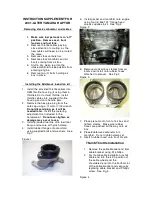
Coupler/Hitch
26
PCMS Operations, Safety & Maintenance V3.0
Ver-Mac 2018
Proper Rigging of Ball and Coupler
1.
Place coupler over the trailer ball on the tow vehicle
2.
Raise the locking lever so that the coupler can drop fully onto the hitch ball
3.
Press the locking lever down on the coupler to ensure the hitch ball fits snugly in the
coupler with no play between the hitch ball and the coupler If there is play, tighten the
adjustment nut until no play is present
4.
To adjust coupler to ball, raise the locking lever, push up on the channel lock and
turn nut to tighten or loosen the coupler
NOTE
Make sure that ball-and-tongue has adequate capacity for the trailer and all
safety (or locking) cotter pins are in place and in good condition.
8.3
Coupler/Hitch Periodic Maintenance
Item
Function Required
Before
Each Use
3
Months
12 months
Coupler/Hitch
Pintle Hook &
Draw Bar
Check capacity
•
Lunette Ring
Inspect for wear
Replace when badly worn
•
•
Coupler and Ball
Inspect for rust
Clean and lubricate ball socket and clamp
lightly with grease
•
Ball and Tongue
Check capacity
•
Safety Pins
Verify that all are in place and properly
inserted
Replace weak or missing pins
•
•
Adjustable Hitch
Make sure bolts are tightened at 150 ft lb
(203 N.m)
•
•
•
Verify hardware to replace it if worn.
•
•
•
8.3.1
Adjustable Hitches
Adjustable hitches provide great flexibility for trailer operators, but bolts must be
safely tightened after performing adjustments to the trailer.
When you change the adjustments on a Ver-Mac adjustable hitch:
• Make sure that all bolts are tightened safely at a torque of 150 ft lbf (203 N.m).
• Replace any worn hardware.
NOTE
Lubrication of the coupler/hitch stops corrosion and helps prevent binding during
turns. It keeps moving parts inside the coupler operating smoothly. A film of clean
heavy weight grease on the ball reduces friction between the coupler and hitch
ball.
















































